
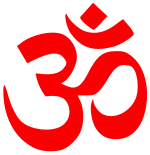
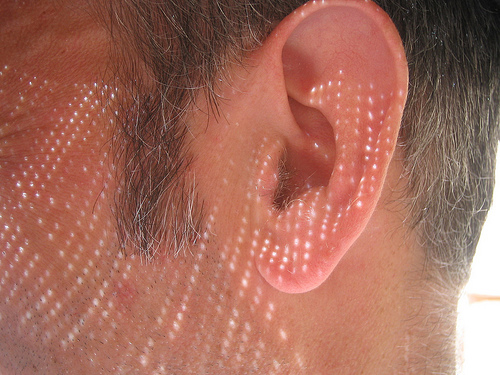
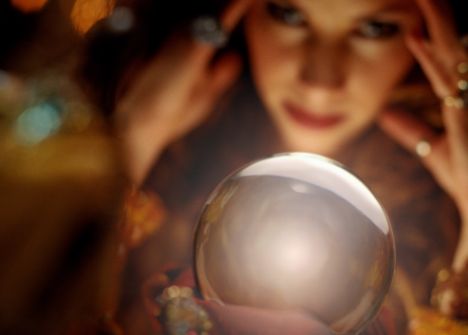

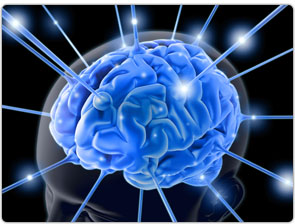
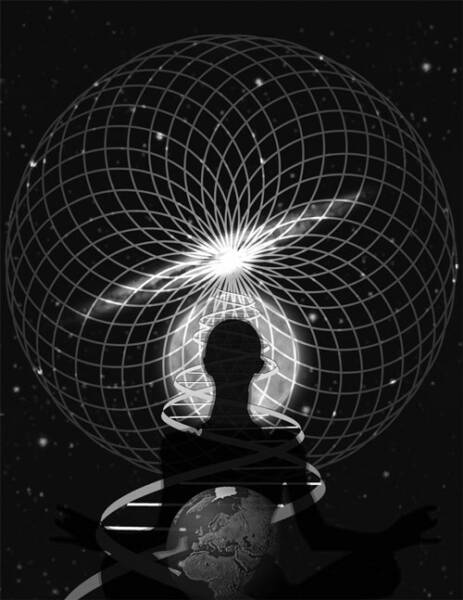
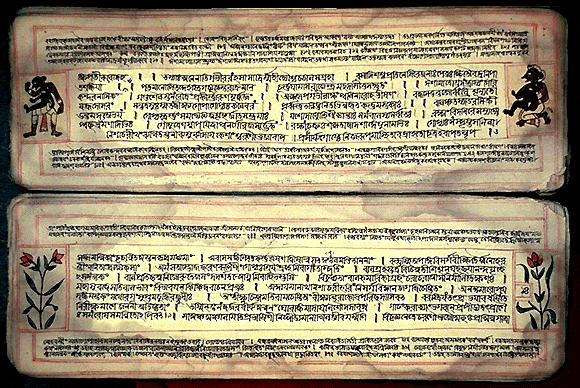
Om or Aum in Sanskrit known as pra?ava [lit. "to sound out loudly"] or Omkara or au?kara (also as Aumkara) (lit. "au? syllable") is a mystical or sacred syllable in the Indian religions, i.e. Hinduism, Buddhism, Sikhism and Jainism.
Aum is commonly pronounced as a long or over-long nasalized close-mid back rounded vowel, [õ??]) though there are other enunciations pronounced in received traditions. It is placed at the beginning of most Hindu texts as a sacred incantation to be intoned at the beginning and end of a reading of the Vedas or prior to any prayer or mantra. The Mandukya Upanishad is entirely devoted to the explanation of the syllable. The syllable consists of three phonemes, a, u and m, which symbolize the beginning, duration, and dissolution of the universe and the associated gods Brahma, Vishnu, and Shiva, respectively.
The name Omkara is taken as a name of God in the Hindu revivalist Arya Samaj
The syllable aum is first described as all-encompassing mystical entity in the Upanishads. Today, in all Hindu art and all over India and Nepal, 'aum' can be seen virtually everywhere, a common sign for Hinduism and its philosophy and theology. Before creation began it was "Shunyakasha", the emptiness or the void. Shunyakasha, meaning literally "no sky", is more than nothingness, because everything then existed in a latent state of potentiality. The vibration of "AUM" symbolizes the manifestation of God in form ("saguna brahman"). The mantra "AUM" is the name of God, the vibration of the Supreme. When taken letter by letter, A-U-M represents the divine energy (Shakti) united in its three elementary aspects: Bhrahma Shakti (creation), Vishnu Shakti (preservation) and Shiva Shakti (liberation, and/or destruction)
Aum is commonly pronounced as a long or over-long nasalized close-mid back rounded vowel, [õ??]) though there are other enunciations pronounced in received traditions. It is placed at the beginning of most Hindu texts as a sacred incantation to be intoned at the beginning and end of a reading of the Vedas or prior to any prayer or mantra. The Mandukya Upanishad is entirely devoted to the explanation of the syllable. The syllable consists of three phonemes, a, u and m, which symbolize the beginning, duration, and dissolution of the universe and the associated gods Brahma, Vishnu, and Shiva, respectively.
The name Omkara is taken as a name of God in the Hindu revivalist Arya Samaj
The syllable aum is first described as all-encompassing mystical entity in the Upanishads. Today, in all Hindu art and all over India and Nepal, 'aum' can be seen virtually everywhere, a common sign for Hinduism and its philosophy and theology. Before creation began it was "Shunyakasha", the emptiness or the void. Shunyakasha, meaning literally "no sky", is more than nothingness, because everything then existed in a latent state of potentiality. The vibration of "AUM" symbolizes the manifestation of God in form ("saguna brahman"). The mantra "AUM" is the name of God, the vibration of the Supreme. When taken letter by letter, A-U-M represents the divine energy (Shakti) united in its three elementary aspects: Bhrahma Shakti (creation), Vishnu Shakti (preservation) and Shiva Shakti (liberation, and/or destruction)
Electroencephalography (EEG) is the recording of electrical activity along the scalp produced by the firing of neurons within the brain.[2] In clinical contexts, EEG refers to the recording of the brain's spontaneous electrical activity over a short period of time, usually 20–40 minutes, as recorded from multiple electrodes placed on the scalp. In neurology, the main diagnostic application of EEG is in the case of epilepsy, as epileptic activity can create clear abnormalities on a standard EEG study.[3] A secondary clinical use of EEG is in the diagnosis of coma, encephalopathies, and brain death. EEG used to be a first-line method for the diagnosis of tumors, stroke and other focal brain disorders, but this use has decreased with the advent of anatomical imaging techniques such as MRI and CT.
Derivatives of the EEG technique include evoked potentials (EP), which involves averaging the EEG activity time-locked to the presentation of a stimulus of some sort (visual, somatosensory, or auditory). Event-related potentials (ERPs) refer to averaged EEG responses that are time-locked to more complex processing of stimuli; this technique is used in cognitive science, cognitive psychology, and psychophysiological research.
Derivatives of the EEG technique include evoked potentials (EP), which involves averaging the EEG activity time-locked to the presentation of a stimulus of some sort (visual, somatosensory, or auditory). Event-related potentials (ERPs) refer to averaged EEG responses that are time-locked to more complex processing of stimuli; this technique is used in cognitive science, cognitive psychology, and psychophysiological research.
In the field of parapsychology, clairaudience is a form of extra-sensory perception wherein a person acquires information by paranormal auditory means. It is often considered to be a form of clairvoyance.Clairaudience is essentially the ability to hear in a paranormal manner, as opposed to paranormal seeing (clairvoyance) and feeling (clairsentience). Clairaudient people have psi-mediated hearing. Clairaudience may refer not to actual perception of sound, but may instead indicate impressions of the "inner mental ear" similar to the way many people think words without having auditory impressions. But it may also refer to actual perception of sounds such as voices, tones, or noises which are not apparent to other humans or to recording equipment. For instance, a clairaudient person might claim to hear the voices or thoughts of the spirits of persons who are deceased. In Buddhism, it is believed that those who have extensively practiced Buddhist meditation and have reached a higher level of consciousness can activate their "third ear" and hear the music of the spheres; i.e. the music of the celestial gandharvas. Clairaudience may be positively distinguished from the voices heard by the mentally ill when it reveals information unavailable to the clairaudient person by normal means (including cold reading or other magic tricks), and thus may be termed "psychic" or paranormal..
Consciousness is variously defined as subjective experience, awareness, the ability to experience "feeling", wakefulness, the understanding of the concept "self", or the executive control system of the mind. It is an umbrella term that may refer to a variety of mental phenomena. Although humans realize what everyday experiences are, consciousness itself resists being defined, philosophers note.
Consciousness in psychology and philosophy typically means something beyond what it means for anesthesiology, and may be said in many contexts to imply four characteristics: subjectivity, change, continuity, and selectivity. Philosopher Franz Brentano has suggested intentionality or aboutness (that consciousness is about something). However, within the philosophy of mind there is no consensus on whether intentionality is a requirement for consciousness.
Consciousness is the subject of much research in philosophy of mind, psychology, neuroscience, cognitive science, cognitive neuroscience and artificial intelligence. Issues of practical concern include how the presence of consciousness can be assessed in severely ill or comatose people;[8] whether non-human consciousness exists and if so how it can be measured; at what point in fetal development consciousness begins; and whether computers can achieve a conscious state
Consciousness in psychology and philosophy typically means something beyond what it means for anesthesiology, and may be said in many contexts to imply four characteristics: subjectivity, change, continuity, and selectivity. Philosopher Franz Brentano has suggested intentionality or aboutness (that consciousness is about something). However, within the philosophy of mind there is no consensus on whether intentionality is a requirement for consciousness.
Consciousness is the subject of much research in philosophy of mind, psychology, neuroscience, cognitive science, cognitive neuroscience and artificial intelligence. Issues of practical concern include how the presence of consciousness can be assessed in severely ill or comatose people;[8] whether non-human consciousness exists and if so how it can be measured; at what point in fetal development consciousness begins; and whether computers can achieve a conscious state
Crystal gazing is a form of divination or scrying achieved through trance induction by means of gazing at a crystal. It is also known as crystallomancy, gastromancy, and spheromancy.
Because crystal gazing has been developed by people of various cultures through a long period of time,[citation needed] the term crystal gazing denotes several different forms of a variety of objects, and there are several schools of thought as to the sources of the visions seen in the crystal gazing trance.
Crystal gazing may be used by practitioners—sometimes called "readers" or "seers"—for a variety of purposes, including to predict distant or future events, to give character analyses, to tell fortunes, or to help a client make choices about current situations and problems.
With respect to the tool or object used to induce the crystal-gazer's trance, this can be achieved with any shiny object, including a crystalline gem stone or a convex mirror— but in common practice, a crystal ball is most often used. The size of ball preferred varies greatly among those who practice crystallomancy. Some gazers use a "palm ball" of a few inches in diameter that is held in the hand; others prefer a larger ball mounted on a stand. The stereotypical image of a gypsy woman wearing a headscarf and telling fortunes for her clients by means of a very large crystal ball is widely depicted in the media and can be found in hundreds of popular books, advertising pages, and films of the 19th, 20th, and 21st centuries. The pervasiveness of this image may have led to the increased use of fairly large crystal balls by those who can afford them.
Because crystal gazing has been developed by people of various cultures through a long period of time,[citation needed] the term crystal gazing denotes several different forms of a variety of objects, and there are several schools of thought as to the sources of the visions seen in the crystal gazing trance.
Crystal gazing may be used by practitioners—sometimes called "readers" or "seers"—for a variety of purposes, including to predict distant or future events, to give character analyses, to tell fortunes, or to help a client make choices about current situations and problems.
With respect to the tool or object used to induce the crystal-gazer's trance, this can be achieved with any shiny object, including a crystalline gem stone or a convex mirror— but in common practice, a crystal ball is most often used. The size of ball preferred varies greatly among those who practice crystallomancy. Some gazers use a "palm ball" of a few inches in diameter that is held in the hand; others prefer a larger ball mounted on a stand. The stereotypical image of a gypsy woman wearing a headscarf and telling fortunes for her clients by means of a very large crystal ball is widely depicted in the media and can be found in hundreds of popular books, advertising pages, and films of the 19th, 20th, and 21st centuries. The pervasiveness of this image may have led to the increased use of fairly large crystal balls by those who can afford them.
Yoga (Sanskrit, Pali: yóga) refers to traditional physical and mental disciplines that originated in India. The word is associated with meditative practices in Hinduism, Buddhism and Jainism. Within Hinduism, it refers to one of the six orthodox (astika) schools of Hindu philosophy, and to the goal towards which that school directs its practices. In Jainism, yoga is the sum total of all activities — mental, verbal and physical.
Major branches of yoga in Hindu philosophy include Raja Yoga, Karma Yoga, Jnana Yoga, Bhakti Yoga, and Hatha Yoga. According to the authoritative Indian philosopher Sarvepalli Radhakrishnan, yoga, based on the Yoga Sutras of Patanjali, comprises one of the six main Hindu schools of philosophy (darshanas), together with Kapila's Samkhya, Gautama's Nyaya, Kanada's Vaisheshika, Jaimini's Purva Mimamsa, and Badarayana's Uttara Mimamsa or Vedanta. Many other Hindu texts discuss aspects of yoga, including the Upanishads, the Bhagavad Gita, the Hatha Yoga Pradipika, the Shiva Samhita and various Tantras.
Major branches of yoga in Hindu philosophy include Raja Yoga, Karma Yoga, Jnana Yoga, Bhakti Yoga, and Hatha Yoga. According to the authoritative Indian philosopher Sarvepalli Radhakrishnan, yoga, based on the Yoga Sutras of Patanjali, comprises one of the six main Hindu schools of philosophy (darshanas), together with Kapila's Samkhya, Gautama's Nyaya, Kanada's Vaisheshika, Jaimini's Purva Mimamsa, and Badarayana's Uttara Mimamsa or Vedanta. Many other Hindu texts discuss aspects of yoga, including the Upanishads, the Bhagavad Gita, the Hatha Yoga Pradipika, the Shiva Samhita and various Tantras.
The Vedas (Sanskrit véda, "knowledge") are a large body of texts originating in ancient India. Composed in Vedic Sanskrit, the texts constitute the oldest layer of Sanskrit literature and the oldest scriptures of Hinduism.
The class of "Vedic texts" is aggregated around the four canonical Sa?hitas or Vedas proper (turiya), of which three (traya) are related to the performance of yajna (sacrifice) in historical (Iron Age) Vedic religion:
The Rigveda, containing hymns to be recited by the hot?;
The Yajurveda, containing formulas to be recited by the adhvaryu or officiating priest
The Samaveda, containing formulas to be sung by the udgat?.
The fourth is the Atharvaveda, a collection of spells and incantations, apotropaic charms and speculative hymns.
According to Hindu tradition, the Vedas are apauru?eya "not of human agency", are supposed to have been directly revealed, and thus are called sruti ("what is heard").The four Sa?hitas are metrical (with the exception of prose commentary interspersed in the Black Yajurveda). The term sa?hita literally means "composition, compilation". The individual verses contained in these compilations are known as mantras. Some selected Vedic mantras are still recited at prayers, religious functions and other auspicious occasions in contemporary Hinduism.
The various Indian philosophies and sects have taken differing positions on the Vedas. Schools of Indian philosophy which cite the Vedas as their scriptural authority are classified as "orthodox" (astika). Other traditions, notably Buddhism and Jainism, which did not regard the Vedas as authorities are referred to by traditional Hindu texts as "heterodox" or "non-orthodox" (nastika) schools. In addition to Buddhism and Jainism, Sikhism and Brahmoism many non-brahmin Hindus in South India do not accept the authority of the Vedas. Certain South Indian brahmin communities such as Iyengars consider the Tamil Divya Prabandham or writing of the Alvar saints as equivalent to the Vedas. In most Iyengar temples in South India the Divya Prabandham is recited daily along with Vedic Hymns
The class of "Vedic texts" is aggregated around the four canonical Sa?hitas or Vedas proper (turiya), of which three (traya) are related to the performance of yajna (sacrifice) in historical (Iron Age) Vedic religion:
The Rigveda, containing hymns to be recited by the hot?;
The Yajurveda, containing formulas to be recited by the adhvaryu or officiating priest
The Samaveda, containing formulas to be sung by the udgat?.
The fourth is the Atharvaveda, a collection of spells and incantations, apotropaic charms and speculative hymns.
According to Hindu tradition, the Vedas are apauru?eya "not of human agency", are supposed to have been directly revealed, and thus are called sruti ("what is heard").The four Sa?hitas are metrical (with the exception of prose commentary interspersed in the Black Yajurveda). The term sa?hita literally means "composition, compilation". The individual verses contained in these compilations are known as mantras. Some selected Vedic mantras are still recited at prayers, religious functions and other auspicious occasions in contemporary Hinduism.
The various Indian philosophies and sects have taken differing positions on the Vedas. Schools of Indian philosophy which cite the Vedas as their scriptural authority are classified as "orthodox" (astika). Other traditions, notably Buddhism and Jainism, which did not regard the Vedas as authorities are referred to by traditional Hindu texts as "heterodox" or "non-orthodox" (nastika) schools. In addition to Buddhism and Jainism, Sikhism and Brahmoism many non-brahmin Hindus in South India do not accept the authority of the Vedas. Certain South Indian brahmin communities such as Iyengars consider the Tamil Divya Prabandham or writing of the Alvar saints as equivalent to the Vedas. In most Iyengar temples in South India the Divya Prabandham is recited daily along with Vedic Hymns






- Home
- Esoteric
- Environmental Awareness
- Ashram
- Lotus Water Lily
- Rose
- Rare Herbal Plants
- Child & Women Empowerment
- Services
- New & Renewable Energy
- Video Gallery
- Members
- Contact Us
